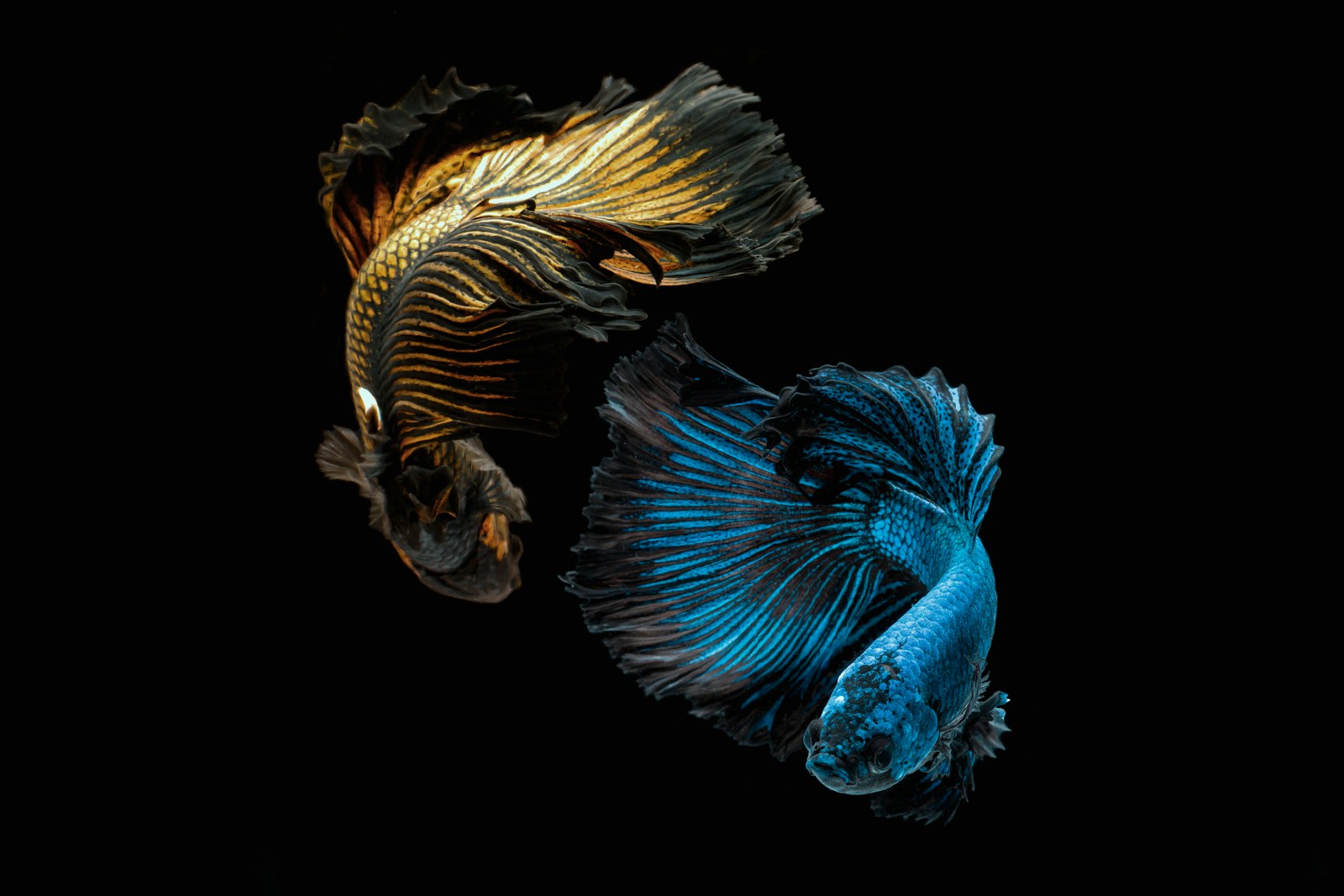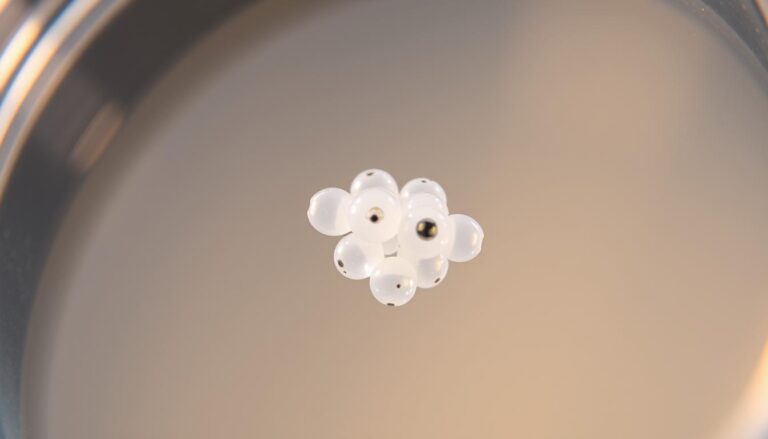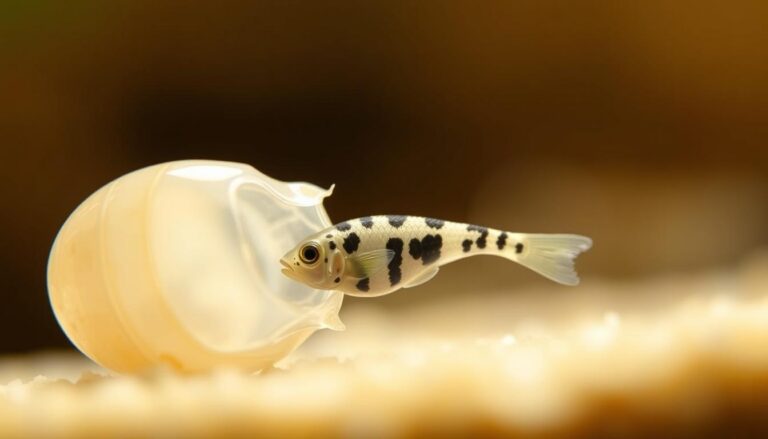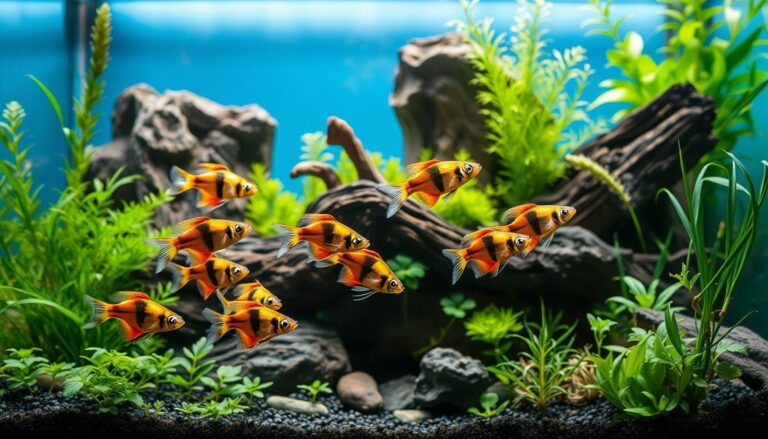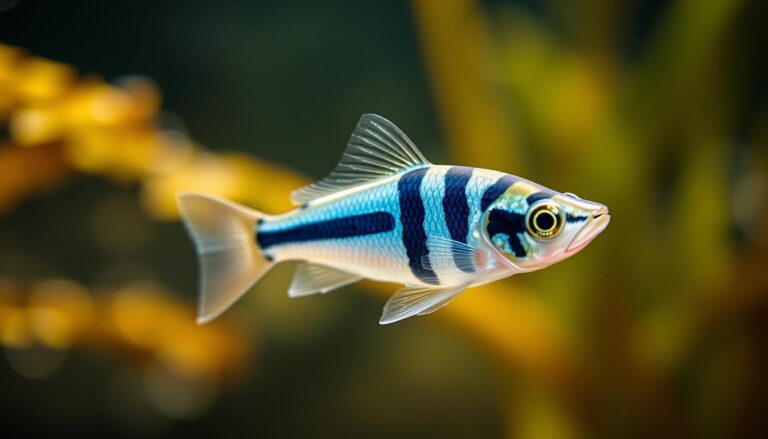Enchanting Blue Betta Fish: Everything You Need to Know
Did you know blue betta fish can recognize their owners and even respond to simple training cues? These vibrant aquatic beauties, known as Betta splendens, are loved by millions of aquarium hobbyists. Their shimmering blue colors, flowing fins, and striking personalities make them highly sought after.
Native to Southeast Asia, blue betta fish have evolved from their wild ancestors into the dazzling pets we see today. From their historical role in ancient Thai fighting traditions to their current status as prized decorative fish, there’s more to these creatures than meets the eye.

Table of Contents
Key Takeaways
- Blue betta fish are intelligent and can learn basic commands.
- Proper tank setup is critical for their health and color vibrancy.
- Wild betta fish differ greatly from the colorful varieties seen in stores.
- They require specific water conditions to prevent common health issues.
- Blue betta fish social behavior is misunderstood, needing careful tankmates.
Introduction to Blue Betta Fish
Blue betta fish are known for their bright colors and lively nature. They are tropical fish, also called Betta splendens. People love them for their vibrant colors and the way they move their fins.
They are also famous for their unique behaviors. For example, they can flare their gills or make bubble nests. This makes them a hit among aquarium fans.
What Makes Betta Fish Unique?
These fish are special because of:
- Coloration: Blue betta fish have colors ranging from royal blue to turquoise. They also have cool patterns.
- Aggressive tendencies: They can be quite territorial. This means they need their own tanks.
- Air-breathing ability: They can breathe air from the surface. This helps them live in low-oxygen water.
Overview of Betta Splendens
Betta splendens come from Southeast Asian wetlands. They like warm, still water. Here’s a comparison of wild and domestic traits:
| Feature | Wild Betta | Domestic Blue Betta Fish |
|---|---|---|
| Color | Earth tones for camouflage | Breeding enhances bright blues and reds |
| Lifespan | 2–3 years | 5+ years with proper care |
| Habitat | Rice paddies, shallow ponds | 10-gallon tanks with plants and hiding spots |
Breeders have worked hard to create the stunning blue betta fish. They have a long history, from being fighting fish in Southeast Asia to being loved pets today.
Setting Up Your Betta Fish Tank
Creating a safe home for betta splendens starts with the right setup. Every detail from tank size to water conditions matters. Follow these steps to give your fish a thriving environment.

Essential Equipment and Tank Setup
- Tank size: Choose a 5-gallon tank or larger. Smaller spaces stress betta splendens.
- Filter: Opt for a gentle sponge filter to avoid strong currents.
- Heater: Maintain 76–82°F with a submersible heater.
- Decor: Add live plants like java fern and smooth rocks for hiding spots.
Optimal Betta Fish Care Tips
Weekly water changes (25%) keep ammonia levels low. Use a dechlorinator during refills. Test pH monthly; aim for 6.5–7.5. Avoid overcrowding—betta splendens prefer solitude. Scrape algae weekly and clean filters monthly. Observe behavior daily; fin flicking or lethargy signal issues.
Housing and Environment for Blue Betta Fish
Creating a great home for your blue betta fish is all about the details. Good care keeps them healthy and active. A well-thought-out habitat helps reduce stress and supports their natural behaviors.

Choosing the Ideal Habitat
- Use a 5- to 10-gallon tank with a secure lid to prevent jumping.
- Add live plants like java fern or anubias for hiding spots—they mimic their wild environment.
- Choose smooth gravel for substrate; sharp decorations can injure delicate fins.
Decorate thoughtfully. Floating plants offer shade, while driftwood provides climbing areas. Avoid overcrowding; bettas prefer calm spaces to thrive.
Water Temperature and pH Balance
Keep water between 76°F and 82°F. A submersible heater with a thermostat helps maintain stable temperatures. Test pH weekly using API test strips, aiming for 6.5–7.5. Use Seachem Prime conditioner to remove chlorine.
“Consistent water conditions are key to long-term betta fish care success,” say aquatic experts at the American Aquarium Society.
Replace 25% of water weekly. Sudden changes in temperature or pH stress fish, leading to health issues. Always acclimate new water gradually.
Betta Fish Diet and Feeding Recommendations
A balanced diet is crucial for your betta’s health and tank setup. Choose high-protein foods like NorthFin Betta Bits (45% protein) or New Life Spectrum BettaMin. Avoid foods with fillers like corn or wheat. These options provide the best nutrition and reduce digestive problems.

- Feed 2-4 pellets 1-2 times daily. Give live/frozen foods like mosquito larvae (67.3% protein) twice a week.
- Fast your betta one day a week to prevent bloating. Overfeeding can harm the tank, so remove uneaten food in 2 minutes.
- Pair meals with proper tank setup practices, like weekly water changes, to keep conditions clean.
Keep a regular feeding schedule—don’t leave food out, as it pollutes the tank. Use sinking pellets to reduce debris. Slowly introduce new foods to avoid digestive issues.
For more on betta nutrition, check out feeding strategies that match tank care best practices. Include fiber-rich foods like algae wafes to aid digestion and tank health.
Understanding Betta Fish Diseases and Health
To keep your betta fish colors bright, you need to know about common health problems. Catching these early can stop big issues. For more info, check out the Betta Fish Diseases Guide. Regular checks help keep your fish looking great and feeling well.
Common Betta Fish Diseases
- Columnaris: You’ll see cottony white patches. Clean water and Kanaplex can help.
- Dropsy: Look for a swollen body and raised scales. Maracyn II is good for bacterial infections.
- Fin Rot: Torn fins with red edges are a sign. Better water quality and aquarium salt can help.
- Ich: White spots on the body mean you need to treat with Rid Ich Plus and keep water stable.
- Popeye: Bulging eyes are a problem. Clean tanks and use Maracyn II to reduce risks.
- Velvet: Gold dust on scales is a sign of velvet. Raise the temperature to 76-81°F and use Copper Safe.
Preventative Care and Treatments
Here’s how to prevent illness:
- Test water weekly for ammonia and pH levels.
- Feed high-quality pellets and live food to boost immunity.
- Quarantine new fish to avoid spreading infections.
- Spot-check fins and body daily for early signs of disease.
Act fast to protect your betta’s health and colors. If problems persist, see a vet.
Caring for Female Betta Fish
Female betta fish do well in groups, known as sororities. A 10+ gallon tank is best for five or more females. For exact tank setup details, visit bettafish.org/care. Keep water temperatures between 76-81°F and pH levels at 6.5-7.5.
- Feed female betta fish high-protein pellets or flakes daily, but avoid overfeeding to prevent bloating.
- Choose non-aggressive tank mates like small tetras or shrimp. Avoid colorful fish to reduce stress.
- Provide hiding spots with plants like java fern to mimic their natural habitat.
Female betta fish are social, unlike males. Keeping them in groups makes their environment richer. Watch for signs of stress, like fins clamped close to the body. Clean water and a proper diet help fight off illnesses like fin rot. Regular small water changes keep their home healthy.
Tip:Always watch how they interact in a sorority. Separate any aggressive ones to keep peace. With the right care, female betta fish add life to your aquarium. Make sure to meet their specific needs to keep them active and colorful.
Breeding Tips for Betta Fish
Creating the right environment is key to healthy betta fish breeding. Start by preparing a separate tank with stable water parameters. This reduces stress and risks of betta fish diseases.
Breeding Environment Setup
Set up a 10-20 gallon tank with soft plants like java moss. Use a divider to separate bettas until ready to breed. Keep the water temperature between 78-80°F and pH 6.5-7.0.
- Include hiding spots with live plants
- Avoid direct sunlight to prevent algae blooms
- Use a gentle filter with low flow
Ensuring Genetic Health
Check both parents for clear fins, active movement, and no signs of betta fish diseases before pairing. Follow these steps:
- Research lineage to avoid inbreeding
- Provide varied diets to boost immune systems
- Quarantine fry until 6 weeks old
Monitor offspring closely—their survival rates reflect parental health. Healthy genetics ensure strong immune systems and vibrant colors in new generations.
Exploring Betta Fish Colors and Varieties
Betta fish display stunning colors thanks to betta fish breeding. Their colors show the beauty of nature. Let’s dive into the world of blue betta fish and what makes each variety special.
Blue Betta Fish Characteristics
Blue bettas dazzle with colors like Royal Blue, Steel Blue, and Turquoise. They love soft light to stay calm. Eating foods rich in color, like brine shrimp, keeps their colors bright.
For more on patterns, check out Splashy Fish Store’s guide. Using full-spectrum LED lights can also highlight their beauty without stressing them out.
Other Color Variants
Bettas come in a wide range of colors, not just blue. Here are some standout shades and their traits:
| Color | Characteristics |
|---|---|
| Red | Fiery hues often paired with intricate tails |
| Green | Emerald shades needing stable water parameters |
| Bi-Color | Two-toned patterns requiring gentle lighting |
Each color has its own care needs. For example, dark-colored bettas might need shaded areas. Betta fish breeding experts often mix colors to keep them vibrant. Always check the specific needs of a variety before getting one.
Conclusion
Raising a blue betta fish needs careful attention to their home, health, and food. This guide covered key topics like setting up their tank, keeping the water clean, and choosing the right food. A balanced diet with high-quality pellets and live food keeps them vibrant and full of energy.
Keeping the water at the right temperature and pH levels is crucial. It prevents stress and disease. Regular cleaning and watching their behavior helps spot health issues early. Choose food rich in protein and vitamins to boost their immune system.
Whether you’re new or experienced, following these tips will help create a great home for your betta. Healthy bettas show off with their fin movements and lively interactions. Share your experiences and ask questions online to learn more and connect with others.
FAQ
What do blue betta fish eat?
Blue betta fish love to eat high-quality food. They enjoy pellets made just for bettas, freeze-dried foods, and sometimes live foods like brine shrimp or daphnia.
How often should I feed my betta fish?
Feed your betta fish once or twice a day. Give them small amounts they can eat in a few minutes. Watch how much they eat to avoid overfeeding.
What should I include in my betta fish tank setup?
Your betta fish tank needs a heater, a filter, and decorations. Plants or caves help them hide. Make sure the tank is at least 5 gallons for their health.
How can I tell if my betta fish is sick?
Look for signs like lethargy, faded colors, and abnormal swimming. Fin rot and ick are common diseases that need quick treatment.
What is the lifespan of a blue betta fish?
Blue betta fish can live 3 to 5 years with good care. Some may even live longer in perfect conditions.
Can I keep a male and female betta fish together?
Male bettas are too aggressive for each other. But, females can live together in a group. Introducing males and females needs careful planning.
How do I breed betta fish successfully?
Breeding bettas requires a special setup and knowledge. You need a separate tank, the right water, and to manage the male and female’s behavior.
What are the most common colors of betta fish?
Betta fish come in many colors like red, blue, green, and purple. Blue betta fish are very popular for their bright look.
How do I maintain the water quality in my betta fish tank?
Keep the water clean by changing it regularly and using a good filter. Keep the temperature and pH level right, between 6.5 to 7.5.
What should I do if my betta fish is not eating?
If your betta fish won’t eat, check the water and temperature. Make sure they’re not stressed. Try different foods to get them interested. If they still won’t eat, see a vet.

